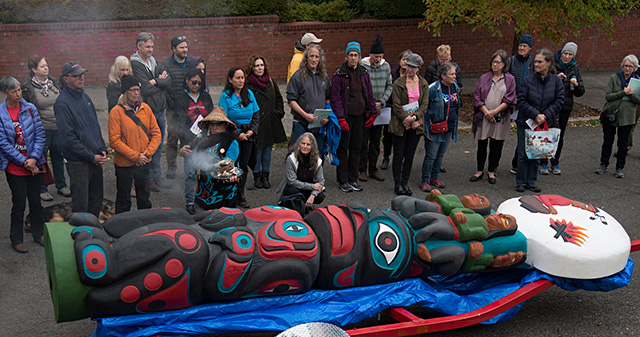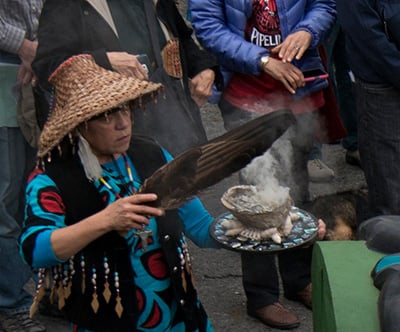
Did you know that Truthout is a nonprofit and independently funded by readers like you? If you value what we do, please support our work with a donation.
Smoke from burning buffalo sage and red cedar circles over a recently carved totem pole. Indigenous tradition says wherever there is sage, evil spirits cannot enter. An elder from the Lummi Nation — a coastal Salish fishing people who’ve lived for millennia on Washington State’s Northwest coast — drums and chants. He urges the crowd gathered at a Seattle church to touch the totem pole and offer blessings for its cross-country journey. Hands reach out to touch an image of a nine-foot bear. At its side are images of salmon and salmon eggs, painted in blue and red ocher. Bears are a part of Lummi mythology, says master carver Jewell James. If rivers and lands are polluted, salmon won’t spawn. Bears won’t eat. At the top of the totem pole is a bowl representing the full moon. Seated next to it is a tribal member performing a fire ceremony, which in Native tradition offers an opportunity to release energy or emotions from the past.
Since 2013, the Lummi Nation has taken totem poles on yearly journeys. Each year, the totem pole has been delivered to a different tribal community confronting fossil fuel projects which threaten sacred lands and waters: the Northern Cheyenne and Crow fighting coal mining in Wyoming and Montana; the Sioux fighting the Dakota Access pipeline in North Dakota. The totem pole journeys are meant to unite and strengthen cooperation between tribes and faith-based, environmental and community allies.
We’re the first generation to recognize climate change and we’re the last generation that can do something about it before it’s too late.
This year, the totem pole journey is doing something different. It’s collaborating with a museum to draw attention to fossil fuel development and climate change. The exhibit, “Kwel Hoy’: We Draw the Line,” is a collaboration between the Lummi Nation and The Natural History Museum. Created by a New York-based collection of artists, scientists and activists three years ago to bring attention to current natural world challenges like climate change into the museum environment, The Natural History Museum is a mobile/pop-up museum. Named in the New York Times and Artnet’s “Best of Art in 2015,” the group’s work has been widely exhibited in museums nationally and internationally. “Kwel Hoy'” opened at the Carnegie Museum of Natural History in Pittsburgh, Pennsylvania, on October 25 for a six-month stay. In the spring of 2018, the exhibit is slated to move to other museums.
Museums as Education Hubs
Surveys show the US public considers museums, especially science and natural history museums, to be among their most trusted sources of information. They see more visitors than theme parks and sporting events combined. “When we learned about the Lummi totem pole journey,” says Beka Economopoulos, co-curator of The Natural History Museum, “we thought it presented an incredibly powerful way to build alliances and help the public understand why Indigenous and allied communities are drawing a line in the sand to block fossil fuel projects.” The exhibit includes the totem pole, a documentation of its journey from Washington State to Pennsylvania, and objects collected on the journey: a jar of water from the Columbia River contaminated with coal; a mural collectively painted by dozens of people — Indigenous and non-Indigenous — along the totem pole journey, and a 150-year-old sacred pipe. These “aren’t just static objects to be isolated and preserved by an institution,” said Economopoulos. Instead, they’re charged with the stories of resilience they’ve picked up on their cross-country journey.
Totem poles are powerful symbols, says Jewell James, the Lummi master carver. And symbols are based on experience “that allow people to interpret what they see based on how they feel inside.” Carl Jung says we dream in symbols, James adds, which connect us to the collective unconscious. “We hope the totem touches into a deeper chord and moves people to action. We always say it’s your constitutional right to assemble and speak out, but you need to make those rights so important to yourself that you’ll stand up and use them. Without you … how are we going to make the change from a fossil fuel economy to a clean energy one?”
The intensity, frequency and duration of hurricanes, droughts, fires, sea level rise and warming rivers has seen a shift in public awareness about changes in extreme weather and climate events. But time is running out, said Freddie Lane, a Lummi photographer and documentary filmmaker traveling with the totem pole. “People need to ask why we’re burning fossil fuels for energy. Why are we destroying the Earth? We’re the first generation to recognize climate change and we’re the last generation that can do something about it before it’s too late.” The exhibit and totem journey are about bringing that message to communities in all states, regardless of political affiliation.
If museums like The Natural History Museum can nurture a chain of solidarity with peoples across the country who are waging climate fights, says Economopoulos, it will go a long way to foster “an informed appreciation of the rich and diverse world we’ve inherited and need to preserve … for posterity.”
 A Lummi woman burns sage. (Photo: Neal Anderson)
A Lummi woman burns sage. (Photo: Neal Anderson)
The Pacific Northwest: The Fossil Fuel Market Nexus
The Pacific Northwest, the region the Lummi Nation inhabits, stands squarely between fast-growing energy markets in Asia and large fossil fuel deposits, including coal, oil and gas in the interior of North America. In order to reach these markets, energy companies like Kinder Morgan and Energy Transfer Partners have proposed to build a range of large fossil fuel infrastructure projects in the Pacific Northwest and British Columbia. Seven new coal terminals, two new oil pipelines, 15 oil-by-rail facilities, six new gas pipelines and multiple petrochemical projects have been proposed in the last five years.
The Lummi Nation prevailed in one of the Pacific Northwest’s biggest fossil fuel fights: a proposal to build the largest coal port ever proposed in North America at Cherry Point, on the coast of Washington. Cherry Point is the last undeveloped bit of shore on a deep-water cove, between a smelter and two oil refineries. Some of the last remaining herring and salmon runs go through these waters. In May of 2016, the US Army Corp of Engineers, the agency reviewing permits for the deep-water port project, agreed that it couldn’t grant a permit for a project that would infringe on the Lummi Nation’s treaty-protected fishing rights. The 34-page decision was celebrated by community groups and tribes all over the Northwest that opposed the coal port.
The Sierra Club, Earth Ministry and others were actively engaged in the multi-year fight to stop the Cherry Point coal terminal. “Now,” says Victoria Leistman, a Sierra Club organizer, “We’re shifting resources to support the work of folks who are being impacted first and worst.” It’s the Lummi’s fisheries and way of life that are being wiped out. They’re also “a strong example of a victory story,” she says. The decision to reject the Cherry Point proposal followed federal obligations to protect tribal treaty rights and the habitat that makes those reserved rights meaningful. It was also based on the fact that the coal terminal was upland from one of the Lummi’s oldest and largest villages and burial grounds.
A Surge of Fossil Fuel Projects
Since 2012, British Columbia, Oregon and Washington have seen a surge of fossil fuel proposals. Six coal terminals have been defeated and one is in litigation. One oil pipeline has been defeated and the other, Canada’s Kinder Morgan pipeline, is being challenged by First Nations in British Columbia. Seven of the 15 oil-by-rail facilities have been pushed back.
“Coal, oil and fracked gas proposals are separate waves of a tsunami,” said Eric de Place, energy policy director with Sightline Institute, a Washington State-based think tank. The first were coal and oil projects. The third and most contentious to date are gas and petrochemical projects, which de Place calls a “fracking beast” because they have so many tentacles. The proposals are coming from the same industry trying to push coal and oil through the region, he says. Projects range from methanol, xylene and liquefied natural gas to liquefied petrochemical projects. De Place’s research also finds the projects would consume large quantities of fresh water, create potentially serious safety and public health risks to local communities, release various forms of toxic contaminants into the air and water, and increase the region’s carbon pollution load.
Since many of the projects drive Canada’s fracked gas industry, tribal communities in the Northwest will have First Nation allies.
“Indian nations are saying ‘no more,'” says Jewell James. “We’re protectors, protecting the land and the water for everyone.”
Media that fights fascism
Truthout is funded almost entirely by readers — that’s why we can speak truth to power and cut against the mainstream narrative. But independent journalists at Truthout face mounting political repression under Trump.
We rely on your support to survive McCarthyist censorship. Please make a tax-deductible one-time or monthly donation.